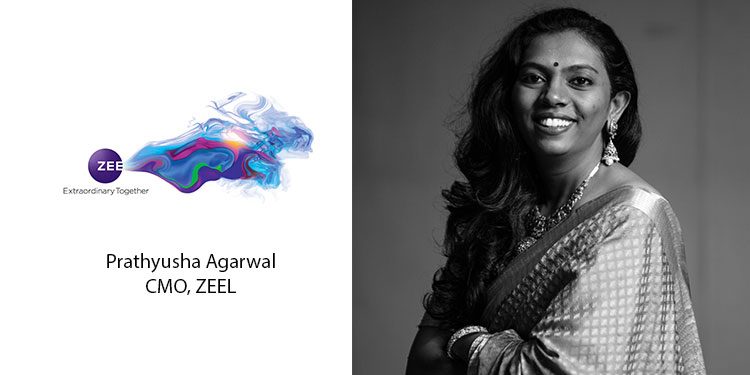While broadcasters have not yet recovered from the impact of TRAI’s new tariff regime. Niche genres such as English entertainment and general news genre are some of the worst hit genres.They continue to bleed in terms of viewership, reach and most importantly revenue. While they are trying hard to recover from all this, TRAI is in process of reviewing the pricing policies as there have been some feedback from consumers that the new tariff has not benefitted them. With the festive season coming in, some broadcasters have announced the reduction in channel pricing, making a desperate effort to stay afloat in the red ocean.
Medianews4u caught up with Prathyusha Agarwal, CMO ZEEL for a brief conversation about the impact of the NTO on ZEE’s business and the industry over all.
Edited excerpts
How has Zee’s television business performed post the NTO?
We are still the number one network and it has been a good quarter, in the Q1 results as you may be aware that we are still the number one and ahead of the closest competitor by atleast 200 bipsso that is something which has worked in our favour. I think the growth has come in a big way from our regional business, as mostly we are the number one or two in across these markets as well. For instance in the Bangla market or the Marathi market we are larger than both the number two and three put together, so somewhere that kind of brand pull which exist in this market ensured that the transition was much faster and hence the viewership performance and the subscription performance really came handy.
If I were to talk about the reach, not only about Zee’s reach but overall also if we take just all the pay channels’ reach, contrary to popular beliefs it has gone up, it is a 5 percent growth all-India and on an HSM level it is a 10 percent growth. South has been constant because their share has increased big time, take Kannada for instance, the share has grown to number one, which is thousand bipsahead of the closest competitor so that has really helped in terms of overall performance.
So even if the reach after NTO has decreased a bit, the time spent on those particular channels have increased…
Yes absolutely, it does.That’s the whole point, if I take reach; total TV level has only gone down by 1 percent so I think that’s come because people have migrated. I think what really happened was that people were watching 50 channels as their regular consumption before NTO. Now, if a household was watching 50 channels that’s come to 40 channels and the TSV of those channels and the reach of those channels is growing up because that’s quality consumption happening, which is great for an advertiser across any TG. The reach and TSV deliver the value for them and that’s the growth story.
Do you think there should be a different yard stick for regional players and niche genres in terms of pricing under NTO?
Why would you consider regional any different from a Hindi speaking market channel, If I would think of Zee Bangla or a Zee Marathi or a Zee Kannada, they are the primary port of call for a consumer of that language, If I have my entertainment need, this is the primary port of call, it is not that because that it is a regional it’s any lesser. For a Tamil consumer, Zee Tamil is the primary port of call and they will be willing to pay to the value for it and that’s possibly the reason why our subscription revenues and the growth that we have got is what it is. It’s early stages on pricing but I think if you put the right value in the market for the product that you’re offering and I don’t see regionals as any lesser than the Hindi GECs. It’s a rating construct of a Hindi speaking market versus regional and sizes of Hindi speaking market larger. Similarly, if the niche channels are for a certain TG and for that TG what is that value they are willing to pay is what we should be charging. I think I can’t reiterate this anymore, we moved from a low involvement bulk purchase decision to a forced involvement unit purchase decision that’s happening currently and it will take a while before the market pricing stabilizes. Some will say that people are buying it or not buying it. Pricing as a variable didn’t exist that has come in play in 6 months, we have seen some amount of user feedback that’s come and going forward it will be a variable which will then play out.
But it would be too early to say, whether niche channels or regionals should be lower so that is something which I would completely rule out. With niche channels I actually think that the consumer is very a loyal consumer and it ends up being a certain premium consumer.There is possibly a chance to get the right content first on TV channels and then grow it rather than to think of it as a top –up, that’s where the fundamental challenge also existed initially because most operators made niche like a top-up and only available in the highest value pack which is basically saying that if I am only a niche consumer unlike the DTH players which had options of metro packs. If I am only an English consumer then I can only get it so people put them in the highest value packs which made it a little difficult for the consumers to subscribe to those.
As per recent reports we have seen a drop in active DTH subscribers from 72.44 million users to 54.26 million users but that information was made public only after TRAI mandated it from DTH operators… Why is there a sudden panic in the industry? Because as per SK Gupta this drop has nothing to do with channel pricing… and the 72.44 MN had subscribers whose connections had been disconnected for over 120 days… so in a way… it was always 54.26 and never 72.44 correct? So why is the industry panicking?
It’s about people who panic and people who don’t understand the numbers or people who are using it to create panic.I would lean towards the latter and we always had this math right and if there is overall 197MN TV households and there is 105 MN cable subscribers and there were always 52 MN on DTH, what used to be reported was the three month average of total subscribers which also included the inactive subscribers. You would have a quarterly update, but now we have a monthly update mandated by TRAI. This brings a lot of transparency into the system and is beneficial to the industry as a whole.
Definitely no panic, I don’t think the DTH players are panicking neither are the broadcasters because ultimately subscriptions and subscriber numbers will be the actual people which won’t go away. Measurement and metrics can keep toying those numbers to mask reality.
So there is a perception that cable and DTH subscribers have resorted to chord cutting practices due to the increase in monthly subscription costs, what would be your response be as a broadcaster and not a network that owns a platform like ZEE5?
On one hand you have 836 MN TV consumers, and on the other hand you have 68 million OTT consumers, clearly there is no chord cutting happening because I believe the people who belong to this 2.5 million and the premium world don’t understand the price sensitivity. TV is for a household at 300 to 350 rupees and even after a whole NTO implementation with all the broadcasters and their top most bouquets cost you 350 bucks, which is for the entire household. If a person would cut the cord per se and on an average subscription to the internet and other OTT services it would cost 5 times more than the TV subscription.
Yes there is very nice and a good AVOD consumption happening on OTT, an add-on consumption which is what we see on ZEE5, Zee Tamil’s Sembaruthiis also watched on Zee5, my numbers of hours on Sembaruthiare increasing as they are watching it on TV as well as on OTT and hence if TSV was like 3 hours kind of a thing on TV, I am getting 3 hours plus another 15 minutes on OTT.
68 million are the total OTT consumers out of which predominantly is catch-up or TV forward content which they are coming here or binge-watching TV content which is happening along with obviously the original content is getting consumed.
In a complex and frequently evolving market conditions, do you see a need for TRAI to change in its functionality micro-managing and what can the industry,, broadcasters and cable operators as a whole together do to bring out everyone from the mix-up?
I would say any sector would need uniform pricing and transparency in that pricing that they have brought in which is supercritical. As complex a geography and as complex a subcontinent as ours where choices and the language of those choices are so varied, it will take a while for people to get used to it and figure it out and I don’t think any of the people in the value chain are trying to create friction.
When I think of the broadcasters and I may speak of ourselves looking at a close consumer research we have kind of created these mixes which make it easier for consumer to choice for example if I am a Tamil consumer versus I am a UP consumer what would be my most preferred basket and hence I will be able to purchase. The value chain down the line has tried executing in its whatever level of technology and capability that existed. I see it as an 18 month kind of a time frame and it will need continuous evolving and tinkering for an iteration to get it right. That is how market pricing happens. Gone are the days when you react after 3 years, this has to be dynamic and look at how is the market reacting to it and relook at the choices you have made. I think is very good and we have a consumer track where people have said that 99 percent of people have moved to making either 74 percent of them have made an active choice for the 24 percent operators transferred over the best fit, and they are quite happy with what they have chosen.
Any change will mean some friction and I think each stakeholder in the value chain is trying to reduce the friction and make it easier for the consumer. I think as long as everyone in the ecosystem keeps the consumer at the center of the table it will get a lot better.

















